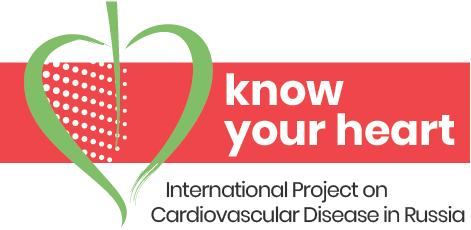Key Aims
One of the key aims of the project is to understand the nature and causes of cardiovascular disease in Russia. In order to facilitate this understanding, we recruited members of the general public from two Russian cities to take part in a study. This study involved collecting data on the current state and appearance of the participants’ cardiovascular system, or in other words, their heart and blood vessels. The study also involved collecting data on the participants’ risk factors for cardiovascular disease.
We selected at random various men and women aged between 35 and 69 who are residents of the Russian cities of Arkhangelsk and Novosibirsk. We then invited these men and women to take part in the study. The 35-69 age range was chosen to include people with a high risk of developing cardiovascular disease. Overall, we aimed to recruit a representative cross-section of people living in these two cities. We also invited patients receiving treatment for alcohol problems in a hospital in Arkhangelsk to become study participants. This is because heavy alcohol use is a CVD risk factor of particular interest to this study.
Data Collection
Data collection for the study had two primary components. Firstly, a baseline interview was carried out in people’s homes, using a structured questionnaire. This interview included questions about various characteristics of each person such as their education and employment status. It also included questions about their behaviours that were related to risk factors for cardiovascular disease, such as smoking, alcohol intake, diet and their level of physical activity. In addition, the interview included questions as to their general health, including mental health (particularly depression and anxiety) and their use of health services.
For the second component, people were invited to attend a medical examination at a clinic. During this examination, very detailed measurements were collected on the participants’ cardiovascular health. These measurements included blood pressure, ultrasound examination of the heart (ECHO) and blood vessels of the neck (vascular ultrasound). In addition, there were measurements of the heart’s rhythm and electrical activity (ECG) and of the speed of blood flow around the body (pulse wave velocity). Measurements were also made of body size and overall physical function, and people were asked about existing health problems, including any history of cardiovascular disease.
Blood samples were taken from the participants during the examination, which will be analysed at the end of the study to assess levels of cardiovascular risk factors such as cholesterol. Participants were also asked to provide urine and stool samples. A further subset of participants had their lung function measured and were also asked to wear a small device called an actiheart for 5 days, which recorded how physically active they were during this period.
In this study, we collected comprehensive information on the structure and function of people’s hearts and blood vessels, which constitutes their cardiovascular profile. We also collected extensive data on a large number of risk factors for cardiovascular disease. We plan to use this data to do the following:
- Investigate the relationship between known cardiovascular risk factors (such as smoking and high cholesterol) and cardiovascular profile in Russia.
- Investigate the relationship between novel risk factors such as gut bacteria (as measured from stool samples) and cardiovascular profile. This part of the study is exploratory.
- Investigate how factors such as education and employment are related to cardiovascular profile in Russia.
- Compare the cardiovascular profile of people living in Russia with people living in other countries such as Norway (where significantly fewer people have cardiovascular disease compared to Russia).
Data collection for the study started in November 2015 and will finish in the autumn of 2017. Thus far, X people have taken part in this study.
